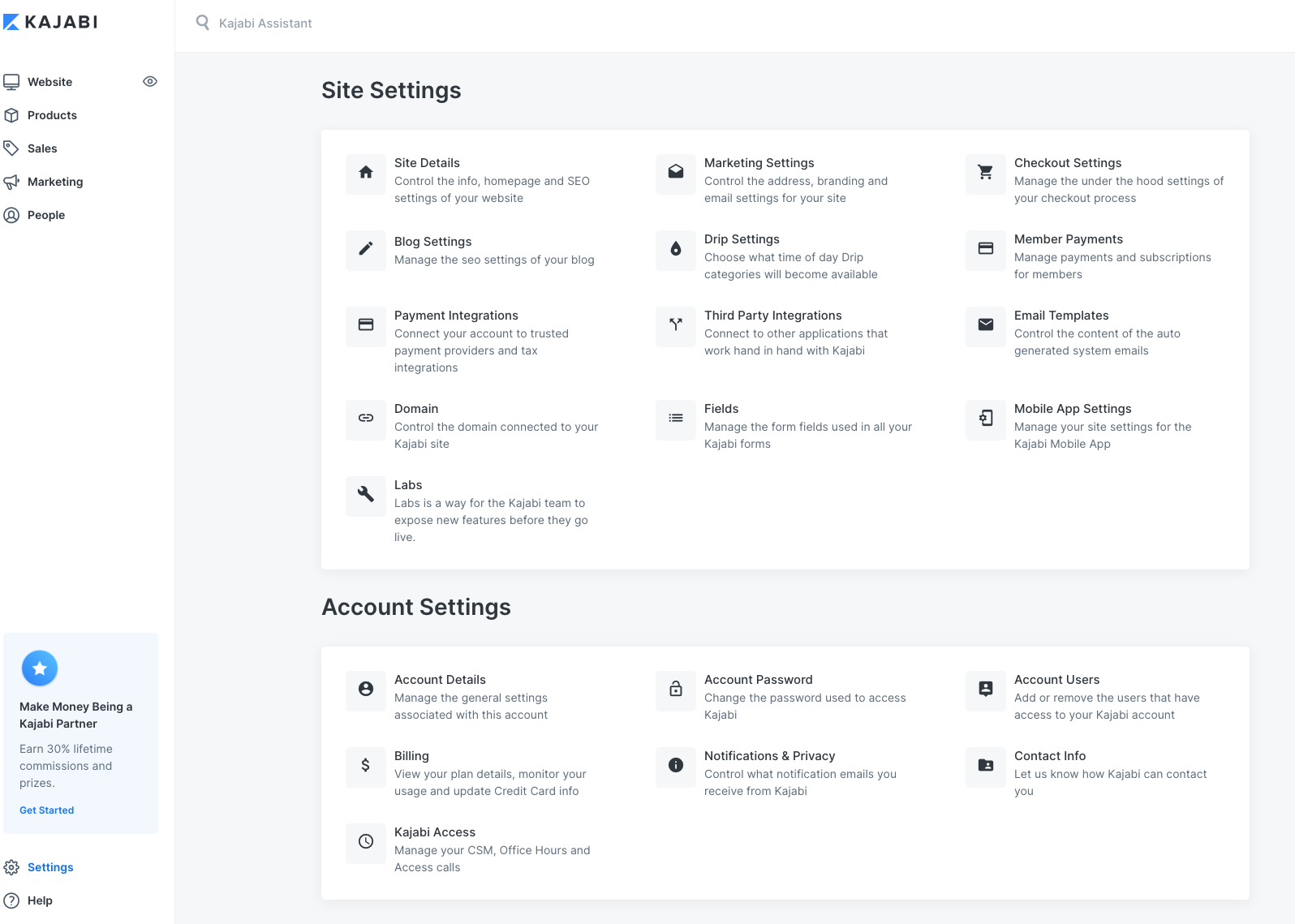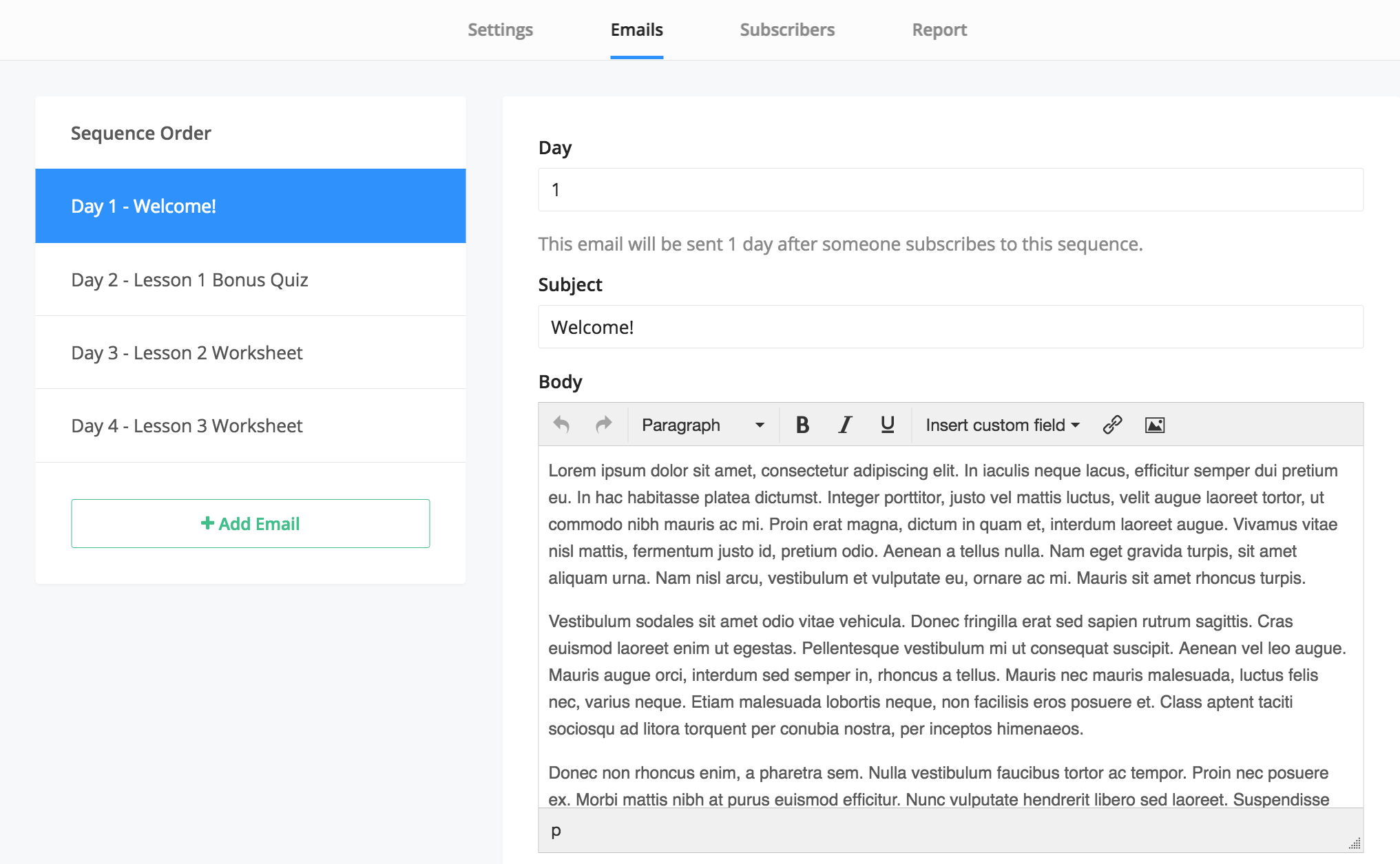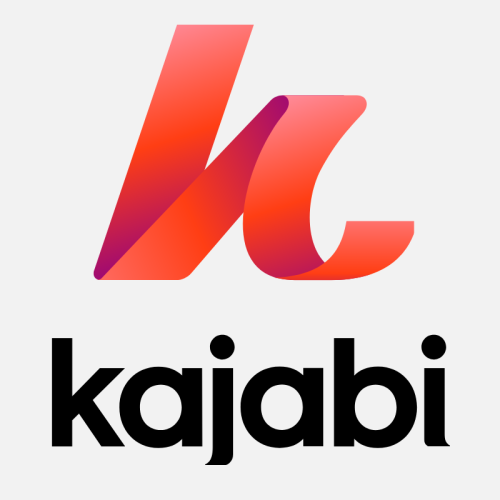If you’re looking to build, launch and scale digital products-courses, membership sites, or coaching programs-the platform Kajabi deserves serious attention. With Kajabi you get a unified system where you can host your site, create content, sell, market and automate everything. In fact, Kajabi creators have generated over US$5 billion in revenue (and analysts project this will climb further in 2025) which speaks to its traction and reliability.
In this Kajabi Review 2025, we’ll walk through who uses it, how it works, its features, pricing, performance, pros & cons, and whether it truly delivers for creators. My aim here is to share expert insights, real-world observations, and clear explanations so you can decide if Kajabi is right for you.

Clean, intuitive interface with a drag-and-drop builder that makes course and website creation simple—even for beginners.
Powerful tools to build, organize, and deliver engaging digital products, memberships, and coaching programs with ease.
Built-in email marketing, sales funnels, and automation workflows that help convert leads and retain customers—no third-party tools required.
Connects smoothly with Stripe, PayPal, Zapier, and other major business apps for streamlined operations.
Comprehensive insights into sales, engagement, and marketing performance to help you make data-driven decisions.
What is Kajabi?
Kajabi is an all-in-one creator commerce platform built to let you build your business online: website, courses, memberships, email marketing, payments and analytics-all in one place. Instead of combining multiple tools (landing page builder + email service + LMS + membership plugin + payments processor), Kajabi aims to provide them under one roof.
The Vision Behind Kajabi
The vision is simple: empower creators and experts to monetize their knowledge without wrestling with tech. Kajabi wants to be the “creator operating system” by offering everything you need so you can focus on your content, brand and audience. As the platform has matured, it’s added deeper marketing automation, analytics and ecosystem features.
Kajabi Pros and Cons
- True all-in-one platform: You don’t need separate course host + email platform + website builder + funnel tool.
- Beautiful interface & modern templates: Fast to launch with minimal tech overhead.
- Strong automation & marketing tools: Automations, funnels, email, membership all built-in.
- Reliable support and continuous product updates: Kajabi regularly adds features and support resources.
- Scalable: From one product to many, with membership and affiliate features.
- Handles hosting/security/back-end: You don’t worry about plugins, updates, hosting issues.
- Premium pricing: Even the entry plans are more expensive than some niche tools. If you only need minimal features, this may feel high.
- Limited design freedom vs open platforms: If you need ultra-custom layouts or advanced web design, Kajabi may feel limiting.
- Feature limits at lower tiers: Product counts, contact limits, funnel counts may require upgrades sooner than you expect.
- Not as ideal if you only need one tool: If you only need simple course hosting and already have email/website/funnel tools, you may over-pay.
- Advanced features require learning: If you want to leverage automations, affiliate programs, integrations—it takes time to master.
Kajabi Pricing Plans (2025 Update)
Here are the updated pricing plans for Kajabi in 2025, along with a breakdown and best-value analysis.
Breakdown of Kajabi Plans
According to multiple sources (2025), Kajabi offers plans like:
| Plan | Price (Monthly) | Key Features |
| Kickstarter | $89/month |
• 1 product • 250 contacts (or higher depending). |
| Basic | $149 |
• 3 products • 10,000 contacts • unlimited landing pages and emails. |
| Growth | $199 |
• 15 products • 25,000 contacts • affiliates, advanced automation, 24/7 chat. |
| Pro | $399 |
• 100 products • 100,000 contacts • multiple sites (3 websites), code editor access. |
Monthly vs Annual Pricing
Choosing annual billing can offer ~20–30% discount versus monthly. For example, the Growth plan monthly ~$199 vs annual ~$159/month equivalent.
If you commit for a year, you save money—but you also lock into the platform for that duration.
Kajabi Free Trial and Promotions
Kajabi offers a free trial (commonly 14-day or sometimes 30-day via special offers) so you can test the platform before committing.
Always check for current promos—they vary.
Which Plan Offers the Best Value?
- If you’re just starting out with one product and limited contacts, the Kickstarter plan may suffice—but the limits (1 product) may constrain growth.
- For most creators launching a few courses/memberships, the Basic plan offers strong value.
- For scaling creators with multiple products, email list growth, affiliates and automation needs, the Growth plan is the “sweet spot”.
- For larger operations, agencies, multiple brands or lots of products, the Pro plan delivers heavy capacity—but comes at a significant cost.
- Value is determined not just by price, but by how much revenue your business can generate. If Kajabi helps you automate, reduce tools, integrate marketing + delivery and scale, the cost becomes justifiable.
Kajabi Overview: How Kajabi Works
The All-in-One Platform Explained
Rather than signing up for a course host + email platform + landing page builder + membership plugin + payment gateway, with Kajabi you log into one dashboard and manage most of these elements. You pick a template, build your offer, set up your site, funnel and emails—and you’re ready to go.
Kajabi Dashboard: Centralized Command Center
Once logged in, you’ll see the main dashboard: key metrics like revenue, active members, new leads, page performance and more. It gives a centralized view of your creator business. You can jump from your website builder, marketing automations, products, payments, members—all within Kajabi.
How Kajabi Combines Course Creation, Marketing, and Sales Tools
Here’s the typical flow:
- Create your product (course/membership) inside Kajabi- upload videos, PDFs, quizzes, module
- Build your landing pages, registration/free-opt-in or paid offer filters inside Kajabi’s website/funnel builder.
- Set up email automation, tagging, triggers (e.g., “when someone purchases”, “when someone completes module”, “when someone abandons cart”).
- Accept payments (one-time, subscription, payment plans) via Kajabi Payments or other gateway.
- Track analytics: funnel conversion, email open/click, course progress, revenue.
- Engage community/members via Kajabi’s membership or community features (if you choose).
The Kajabi Ecosystem: Website, Courses, Email, and Community in One
The beauty of Kajabi is the ecosystem: your website lives in Kajabi, your digital product lives in Kajabi, your marketing funnels live in Kajabi, your courses and membership live in Kajabi. Everything is tied together. That reduces friction, plugin conflicts, integration issues and tech headaches. Especially helpful if you prefer focusing on content rather than backend tech.
Who Should Use Kajabi?
You should consider Kajabi if you are:
- A coach, consultant or creator selling courses, memberships or digital products.
- Building a business where marketing, content delivery and monetisation need to be integrated.
- Tired of managing 5-10 separate tools (website builder, email service, LMS, funnel tool) and want something central.
- Planning to scale your audience, automate workflows and create multiple offers or membership tiers.
- Comfortable investing in a premium platform because you expect returns through productivity gains and integrated workflows.
Who Should NOT Use Kajabi?
Kajabi might not be the right fit if you are:
- On a very tight budget and only need simple hosting of one course or membership.
- Already have best-in-class email/automation tools and only need course hosting or membership features.
- A blogger or content creator who isn’t monetising through courses or memberships and doesn’t require funnels, automation or e-commerce.
- Seeking ultra-custom website design or extremely bespoke user experiences beyond what Kajabi’s themes allow.
- Using corporate training with SCORM/AICC compliance or need LMS features outside Kajabi’s scope.
Kajabi Key Features & Tools
Here’s a breakdown of Kajabi’s major capabilities-grouping them into feature categories for clarity.
Course Creation & Management
- Course Builder & Templates: Kajabi provides templates and modules so you can structure your course quickly.
- Uploading and Organizing Content (Videos, PDFs, Quizzes): You can upload lesson videos, PDFs, and quizzes, organize modules and lessons.
- Drip Content and Progress Tracking: You can schedule content to drip (release over time) and monitor student progress—helping manage member engagement and timing.
Website & Landing Page Builder
- Drag-and-Drop Page Editor: No coding required. You pick a template, drag components, drop them, preview and publish.
- Custom Domains and Themes: Use your own domain, apply your brand theme, customise page layout.
- SEO Optimization Tools: Kajabi supports meta tags, page URLs, site structure and other SEO essentials—ideal if you want your site to rank in search.
Marketing & Automation
- Kajabi Pipelines (Sales Funnels): Kajabi includes pre-built pipeline blueprints—launch funnels, evergreen funnels, webinar funnels, product launch funnels.
- Email Campaigns & Automations: Build automated email sequences, behaviour-based triggers, tagging & segmentation.
- Forms and Lead Generation Tools: Capture leads via opt-in forms, landing pages, pop-ups; then nurture them via automation.
Memberships & Communities
- Creating Membership Sites: Kajabi supports membership models—recurring access, gated content, hybrid course + community models.
- Engaging with Students and Members: Build community spaces, discussion areas, allow comments, or integrate membership portals.
- Monetization Options: Charge for membership, set up subscription plans, tiered access, bundle offers.
Payments & E-Commerce
- Kajabi Payments and Stripe Integration: Kajabi includes its own payments infrastructure (in supported regions) and integrates with gateways like Stripe.
- Checkout Customization and Coupons: Create checkout pages, apply coupons/discounts, upsells/downsells, payment plans.
Analytics & Insights
- Revenue Reports and Customer Metrics: Track gross revenue, refunds, active members, ARPU, subscriptions.
- Marketing Performance Dashboards: Monitor email open/click rates, funnel conversion, landing page traffic & performance.
Integrations & Apps
- Native Integrations (Zoom, Stripe, PayPal, etc.): See connections with live webinar tools, payment processors, etc.
- Third-Party Integrations via Zapier: For advanced workflows, you can integrate Kajabi with thousands of apps via Zapier.
- API Access for Developers: For more custom workflows and external systems, Kajabi offers API access (depending on plan).
Kajabi Performance & User Experience
Ease of Use
Kajabi is designed to be creator-friendly. The drag-and-drop interface, pre-built templates and unified system mean that even non-tech users can build a business. That said, because Kajabi offers many features, there is still a learning curve—especially when you dive into automation, affiliate systems, custom branding. According to user reviews, new users often take a few weeks to fully master the workflow.
Onboarding Experience and Learning Curve
Kajabi provides onboarding resources: tutorials, its Kajabi University, training videos and community forums. That helps flatten the learning curve. But if you aim to use advanced features (multiple products, affiliates, automation sequences, integrations), expect some upfront time.
The interface is modern and fairly intuitive; still, navigation between “Website”, “Products”, “Marketing”, “Community” modules may feel dense initially.
Automation Capabilities
One of Kajabi’s standout strengths is automation: you can trigger actions based on student behaviour (module completion, membership renewal, email opens), tag contacts, run sequences and funnel logic—all built-in. That allows scaling and more personalised marketing.
Customization & Flexibility
Kajabi offers customization: your branding (logo, colours, fonts), site themes, course layouts, email templates. On higher tiers you get custom code editor access for deeper tweaks. While this is strong, some users note that for the ultra-custom design (complex layouts, totally bespoke site) platforms like WordPress + custom builder still offer more flexibility. In short: Kajabi trades some design freedom for convenience and speed.
Supported Languages & Accessibility
Kajabi is global: it supports creators from many regions, offers multilingual support via your own content, and the platform is mobile responsive. Mobile experience is good and accessible. Some creators report that their students access courses via mobile more than desktop (as trends show mobile learning is rising). Ensuring your content and design are mobile-friendly remains important.
Customer Support & Resources
Kajabi offers solid support: knowledge base, forums, tutorials, live chat. On higher plans (Growth/Pro) you get priority support, sometimes 24/7 chat. Users generally praise the support, though response time may vary based on plan. Community resources (creator forums, peer groups) are also valuable.
Security & Reliability
Kajabi handles hosting, updates, backups, security (SSL, encrypted payments) and infrastructure. For most creators this means low tech burden. Uptime and stability are strong—being a mature platform with many users. If you’d otherwise have to manage hosting + LMS + site + integrations, Kajabi simplifies that significantly.
Kajabi Screenshots & Visual Walkthrough
Even without seeing the actual interface, you can imagine Kajabi’s clean, professional layout — where every tool feels logically placed and designed for creators who value simplicity and efficiency. Below is a visual walkthrough of Kajabi’s core screens and what each one offers.
1. Dashboard Overview

At a glance: Your entire business performance in one snapshot.
When you first log in to Kajabi, you’re greeted by a sleek, minimalist dashboard that gives you a bird’s-eye view of your business. The main panel displays real-time analytics, including:
-
Revenue metrics: Track your total sales, subscription income, and refunds.
-
Leads overview: See how many new contacts and opt-ins you’ve generated.
-
Product performance: Monitor which courses or offers are converting best.
-
Pipeline snapshots: Visual graphs show funnel performance and drop-off points.
Navigation tabs on the left keep everything one click away — Products, Marketing, People, Website, and Analytics — making it easy to move between creation and management without feeling lost.
2. Course Builder Screen

Create structured, engaging learning experiences with ease.
Kajabi’s course builder is where your content takes shape. The interface is drag-and-drop friendly, showing your course as a hierarchy of:
-
Modules (Categories) → Lessons (Posts).
Each module can be expanded to reveal its lessons, with clear “Add Content” buttons for uploading:-
Video lessons (MP4 or embedded links)
-
PDFs or downloadable files
-
Audio-only versions
-
Text-based lessons or assessments
-
You can also add quizzes or assignments for engagement and track student progress automatically. On the right-hand preview panel, you’ll see how your students will experience the course in real time — complete with progress bars, comments, and access control settings.
3. Website & Landing Page Builder

Design a high-converting, branded online presence — no coding required.
Kajabi’s website and landing page builder uses an intuitive drag-and-drop interface. Imagine a clean, white canvas with modular blocks you can add or rearrange — hero sections, testimonials, opt-in forms, pricing tables, and more.
Key elements you’ll notice:
-
Theme Preview Panel: Instantly see how your changes look on desktop, tablet, and mobile.
-
Customization Sidebar: Adjust fonts, colors, and spacing globally or per section.
-
Custom Domain Integration: Easily connect your own domain for a professional finish.
-
Built-in SEO & Analytics Tools: Optimize page titles, meta descriptions, and tracking without leaving the editor.
Every page is designed to load fast and look polished — even for users with no design background.
4. Pipeline Builder (Funnel Builder)

Map out your entire marketing journey with visual clarity.
Kajabi’s Pipeline Builder gives you a visual “map” of your marketing funnel — from opt-in to conversion. Think of it as a flowchart where each stage is represented by connected cards.
Typical pipeline flow:
-
Opt-In Page → Offer Page → Checkout → Thank You Page → Email Automation
You can drag and connect each element, preview pages directly, and add automation rules like:
-
Sending a specific email sequence after purchase
-
Tagging leads based on behavior
-
Triggering upsell or downsell offers
The pre-built pipeline templates (like “Product Launch,” “Webinar Funnel,” or “Coaching Campaign”) make it easy to launch complex marketing systems with just a few clicks.
5. Email Automation Screen

Engage your audience with intelligent, behavior-based automation.
Kajabi’s Email Automation area combines visual logic with simplicity. You’ll see a flow-style interface where each trigger connects to an automated sequence — much like a mind map.
Here’s what you can do:
-
Set triggers: A purchase, opt-in, or lesson completion can start an automation.
-
Add actions: Send emails, apply tags, subscribe users to sequences, or offer coupons.
-
Segment audiences: Use filters and tags to personalize emails by behavior or interests.
-
Sequence builder: Create multi-step drip campaigns, set delays, and preview messages.
Everything is built to keep communication consistent and personal — without manually managing every subscriber.
Seeing these visuals helps you get a feel for how everything ties together in Kajabi.
Alternatives to Kajabi
Here’s a quick comparison of Kajabi and some popular alternatives:
- Kajabi vs Teachable: Teachable is more course-host focused (less built-in marketing). If you just need course hosting, Teachable may be cheaper, but if you need marketing + email + funnel features, Kajabi wins.
- Kajabi vs Thinkific: Thinkific offers strong course hosting and community features, often at lower cost. But it may require add-ons or external tools for full marketing stack.
- Kajabi vs Podia: Podia is simpler, great for selling digital products and memberships, with a lower price point—but fewer advanced automation features.
- Kajabi vs Kartra: Kartra is also all-in-one with heavy marketing funnel focus. Kajabi leans more on courses/memberships + integrated marketing; Kartra emphasizes funnel + marketing automation first. Depending on your focus, one may suit better than the other.
Final Verdict: Is Kajabi Worth It in 2025?
In short: yes—Kajabi is worth it if you align with its strengths.
Strengths: It simplifies your tech stack, centralises your business operations, supports automation, marketing, content delivery and monetisation in one platform. For creators ready to grow, launch multiple offers, build memberships and scale, it’s a powerful choice.
Limitations: The cost is high relative to minimal use-cases, and for purely simple course hosting you might be over-paying. Also, if design freedom or ultra-custom websites are your focus, Kajabi may feel constrained.
Our Recommendation: If you’re serious about building a creator business, not just dipping your toes, then Kajabi is a smart investment. Use the free trial, map your product roadmap (how many courses, membership tiers, list size, automation needs) and choose a plan accordingly. If you’re just starting extremely small, evaluate if maybe a lower-cost tool fits until you scale.
Ultimately, if Kajabi helps you launch faster, automate smarter and focus on growth rather than tech, it can pay for itself in time saved and revenue gained.
FAQs About Kajabi
Q1: Is Kajabi good for beginners?
A1: Yes—Kajabi is designed with non-tech users in mind: drag-and-drop builders, templates, training materials and unified platform. That said, to get full value (automation, funnels, affiliates) you’ll invest a bit of time learning.
Q2: Does Kajabi take a transaction fee?
A2: Kajabi itself doesn’t charge an extra platform transaction fee on its standard plans (aside from payment gateway fees) in many regions. The exact payment fees depend on your region and payment processor.
Q3: Can you use Kajabi for free?
A3: Kajabi offers a free trial (14-30 days depending on promotion) so you can test features without committing. After the trial you’ll need to choose a paid plan.
Q4: Does Kajabi replace Mailchimp or ConvertKit?
A4: In many cases yes—Kajabi includes email marketing, automation, tagging, sequences and integrates marketing workflows. If you use Kajabi fully you may not need separate email tools. But if your email/automation needs are highly advanced you may still use dedicated tools alongside.
Q5: How secure is Kajabi for online courses?
A5: Kajabi is secure: it provides SSL encryption, handles hosting and updates, supports payments, and backs infrastructure management for you. For most creators this is a major advantage—no plugin risk, fewer tech headaches.

